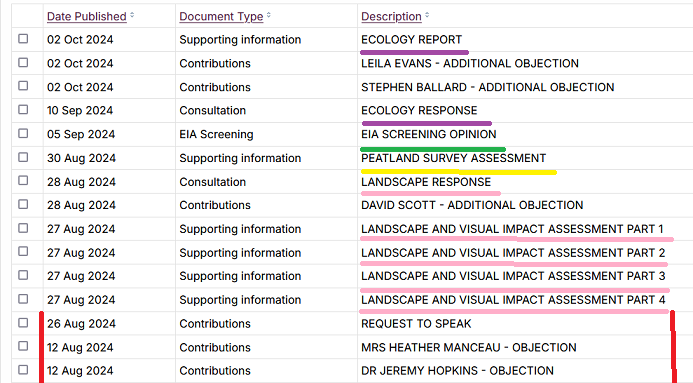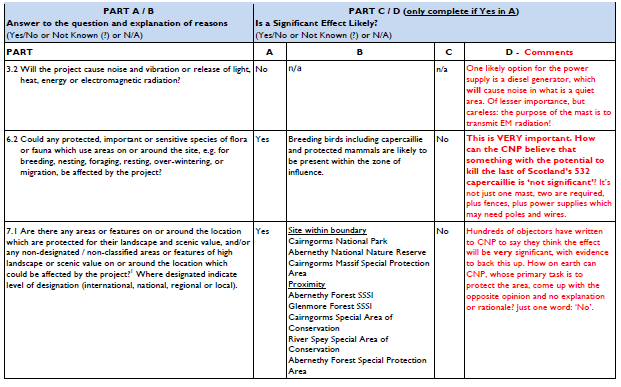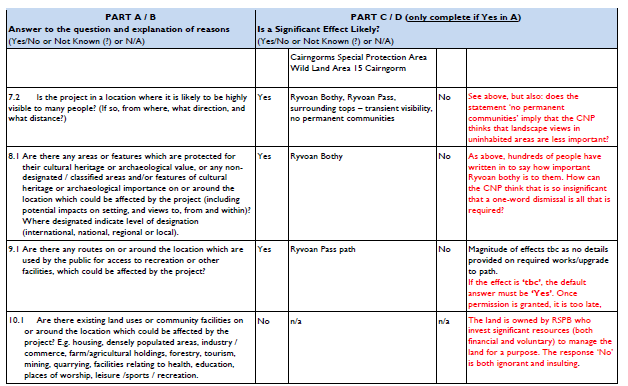
Between the 11th July and 12th August – the statutory minimum period the Cairngorms National Park Authority (CNPA) allows the public to comment on planning applications – c530 individual objections were published on the CNPA planning portal objecting to the proposed telecommunications mast at Ryvoan. Since 12th August the CNPA has published NO further objections, only additional material from people who had already objected and wanted to supplement what they had said. It has, however, published a four part Landscape and Visual Impact Assesssment (LVIA) and Landscape Response, an Ecology Report and Ecology Response, a Peatland Survey Assessment and an EIA Screening Opinion:

On 2nd October the CNPA emailed those who had objected to the application within the minimum statutory time period saying:
“Anyone wishing to submit additional comments, relating specifically to this information, should do so in writing to Cairngorms National Park Authority, 14 The Square, Grantown on Spey, PH26 3HG or email planning@cairngorms.co.uk by 23 October 2024″.
The problem is NOT ANYONE can object or comment on the new documents, only the 530 or so who objected within the CNPA’s deadline. This is manifestly unfair and designed to favour the developer as these nine new documents will play a crucial role in determining what planning officers recommend for this planning application.
In that respect it is worth noting from the detailed (and excellent) Landscape Response dated and published on 28th August that the LVIA must have been provided to the CNPA planners well before the publication date of 27th August. Whether or not the CNPA deliberately delayed the publication of LVIA to prevent the public from commenting publicly before their deadline, the point is the public should have had the right to comment on such documents. Public comments play a crucial role in raising issues that would otherwise be “missed” or ignored by staff and holding them to account.
Despite asking in their email of 2nd October for additional comments by letter/email, unlike previous planning applications the CNPA has not in this case blocked people from using the comment facility on the planning portal. I have done so and you can try do so here. Given their past record and what they have stated in their email, however, it appears unlikely they will approve comments from anyone commenting for the first time. I have now made a number of requests to the Head of Planning, Gavin Miles, for the CNPA to amend their standing orders to enable the public more time to comment (as happens in the Loch Lomond and Trossachs National Park Authority) and make those comments public. So so far nothing has changed.
Grant Moir, the Chief Executive of the CNPA, referred to the number of objections to the Ryvoan mast in his report to the board (see here – para 13) on 13th September:
13. Planning casework …………………………. A planning application for a new telecoms mast in Glenmore was recently withdrawn and another for a new mast near Ryvoan bothy has generated significant public interest, with more than 520 objections received.
Mr Moir failed to explain that he was citing the number of objections received in the statutory period and failed to state how many people had tried to object after that. His statement that the “new telecoms mast in Glenmore was recently withdrawn” is also misleading because in August the developer made it clear they intend to submit a new one (see here).
The CNPA Environmental Impact Assessment scoping opinion for the Ryvoan Mast
In 2017 the Scottish Government incorporated the EU’s Environmental Impact Assessment Directive into planning law and issued guidance (see here) about its use:
4. The main aim of the EIA Directive is to ensure that the authority granting consent (the ‘competent authority’) for a particular project makes its decision in full knowledge of any likely significant effects on the environment. The Directive therefore sets out a procedure that must be followed for certain types of project before they can be given ‘development consent’. This procedure – known as Environmental Impact Assessment or ‘ EIA‘ – is a means of drawing together, in a systematic way, an assessment of a project’s likely significant environmental effects. This helps to ensure that the importance of the predicted effects, and the scope for reducing any adverse effects, are properly understood by the public and the competent authority before it makes its decision.
While developers are encouraged to request scoping opinions as to whether an EIA is required BEFORE submitting planning applications, there is nothing to stop a planning authority deciding an EIA is required. The CNPA, however, only did so AFTER their deadline for public comments had expired meaning that anyone who did not comment previously is unable to comment on the EIA and whether it is fit for purpose (there are lawyers out there who did not object to the original documentation but who might well have objected to the screening opinion). David Craig, who has objected to the application and has contributed a number of posts to Parkswatch (see here), (here), (here), (here) and (here) has raised issues about the scoping opinion with CNPA planning staff which have not as yet been been published on the planning portal. Parkswatch is therefore very pleased to publish his comments.
Extracts from EIA Screening of 2024/0179/DET( Mast at Ryvoan) by CNP dated 5 September 2024


David’s comments show just why it is so important that the CNPA publish ALL comments they receive on planning applications.
While the CNPA’s screening opinion shows they see the environmental impacts of the Ryvoan mast as being of no account under the EIA regulations – which makes it easier for staff to recommend it be approved – their wider failure is to consider the environmental impacts of the Shared Rural Network as a whole on the National Park. The point is that ALL the masts proposed for the Cairngorms National Park are related as each mast has to communicate with another and forms part of a network. Moreover, the Ryvoan mast is part of the “Shared Rural Network”, a single programme to eliminate partial and total not spots in telecommunications coverage. So why has the CNPA issued a screening opinion about the need for an EIA for the Shared Rural Network programme as a whole, instead of doing this for individual masts?
While the CNPA planners may not agree, the public – as illustrated by the very large number of objections in this case – clearly believe the environmental impacts of telecommunications masts can be very significant. (An EIA looking at proposed masts in the Cairngorms National Park as a whole would help separate out those that are acceptable and those that are not).
Assuming “Three” does not now withdraw the application for a mast at Ryvoan, when the CNPA’s Planning Committee come to consider it they should not only reject the application but start acting like a National Park: a good start would be to draft supplementary planning guidance on telecommunications masts, for public consultation, and to ask the Shared Rural Network programme to submit an EIA considering the impact of the proposed developments across the National Park as a whole.
Ryvoan is turning into a test case for telecommunications masts in the Cairngorms National Park and it is important that as any people as possible continue to object and to comment on the documents published on the planning portal since 12th August (see here for documents). If you have any problems doing so, or if the CNPA refuses to publish your comments, please let Parkswatch know.

https://cairngorms.co.uk/park-authority-planning-committee-news-2/. It just gets worse.
Well said, Nick. There are numerous issues arising on a regular basis concerning CNPA Planning, procedures and increasingly poor quality of planning officer reports to Committee.
You cover off several problems with the CNPA’s screening opinion on this application, but there is yet another blunder which calls into question the competency of this screening opinion. I refer to question 1.1 – Will construction, operation or decommissioning of the project involve actions which will cause physical changes in the topography of the area?”. The planner inserts, “Levelling and micro siting of each element of play equipment will be required, as the site is fundamentally not level….”. There is NO play equipment associated with this proposed telecoms mast! This is clearly a cut and paste from another report. We are left asking what other parts of this screening opinion are just cut and paste? The impression left is that this screening opinion is just another CNPA rubber stamping exercise.